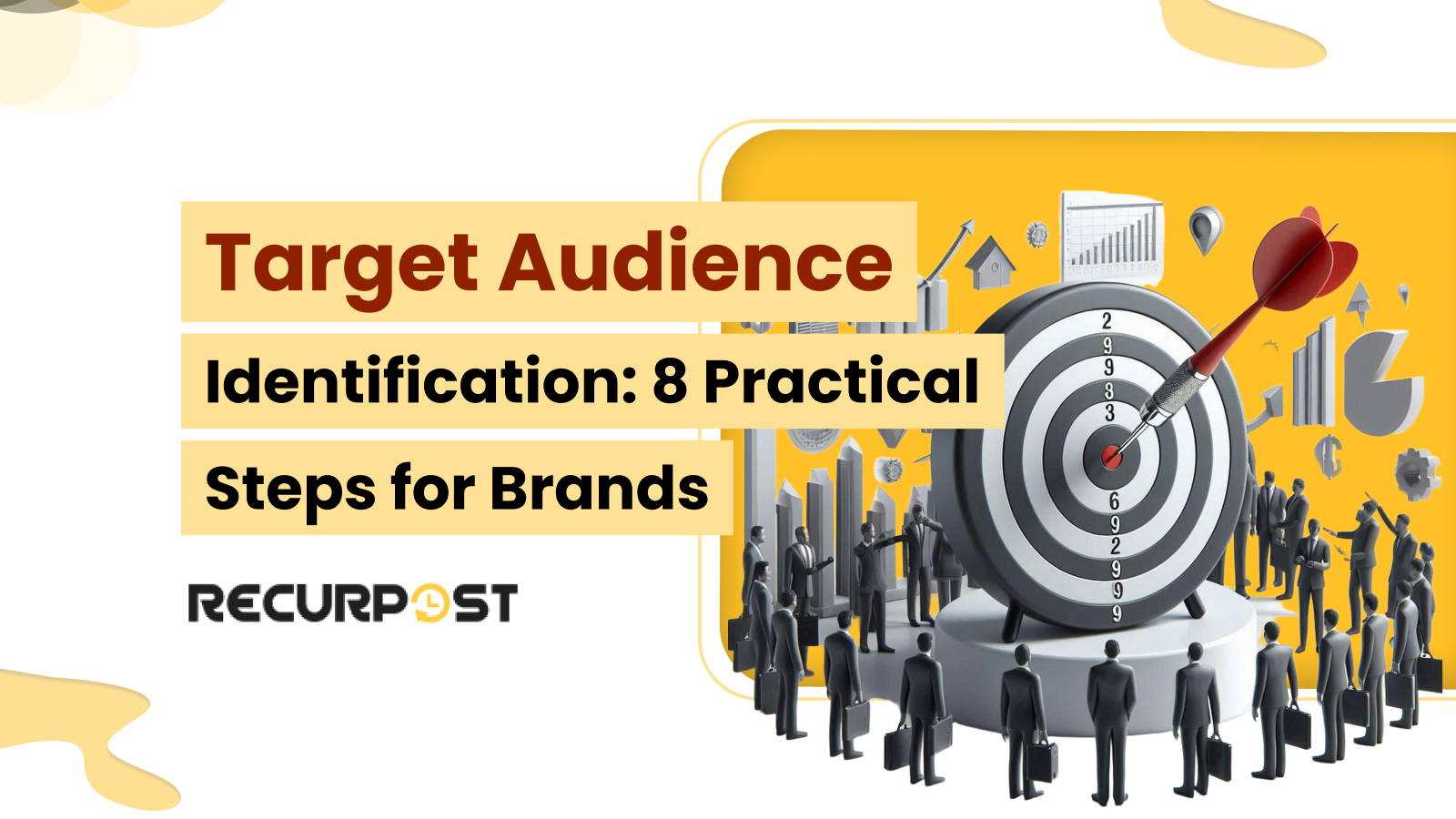You’ve created the perfect product. Your marketing copy is compelling. Your website looks professional. But your sales trickle rather than flow. Sound familiar?
The problem isn’t your product or your marketing skills. The problem is simpler and more fundamental: you’re talking to the wrong people. Something is lacking in your target market research.
Finding your target audience resembles a conversation at a crowded party. When you address everyone simultaneously, your voice disappears in the noise. When you focus on the right person genuinely interested in your message, you capture their complete attention.
This is exactly what happened to Dollar Shave Club. Instead of competing with Gillette for everyone who shaves, they focused on one specific group: men frustrated with overpriced razors who appreciated humor and convenience. That laser focus helped them build a billion-dollar company.
While countless methods exist to identify your specific target audience, this practical guide highlights 8 powerful audience targeting strategies designed to help you find your ideal customers who genuinely need your product or service. Each method serves as a practical step that businesses can implement to systematically identify their target audience through data analysis, customer research, and market observation.
Whether you’re launching a new brand or refining your marketing strategies, these proven methods will help you identify, understand, and connect with your ideal target audience.
Why Most Businesses Get Target Audiences Wrong
Identifying your target audience profile requires understanding consumer psychology. Most businesses make one critical mistake: they confuse “people who might buy” with “people who will buy”.
Here’s the difference. Imagine you’re selling premium yoga mats. Your product could appeal to “anyone who exercises” or “anyone into wellness”, but casting such a wide net makes your marketing weak.
That represents millions of people with zero clarity. Addressing everyone means resonating with no one. Success comes from narrowing who needs your offering, why they need it, and where you can reach them.
Instead of “anyone who exercises”, think:
Yoga practitioners who practice 3+ times a week, care deeply about comfort and alignment, can feel the difference between mats, and are willing to pay more for lasting quality.
That defines a specific target audience, not just a broad group.
Knowing exactly who you’re speaking to enables you to tailor messaging, products, and platforms to match them perfectly. Though this might target thousands rather than millions, these people will open their wallets.
Specificity drives results. Knowing exactly who you’re addressing makes every aspect of your marketing effort more effective.
Your ideal customers don’t wear name tags. They scatter across different platforms, hide in various communities, and mix with people who appear similar but behave differently. Finding them requires a systematic approach.
These 8 methods each reveal a different piece of the puzzle, giving you a complete picture of who your prospective customers are.
Start With the Existing Customers’ Behavior
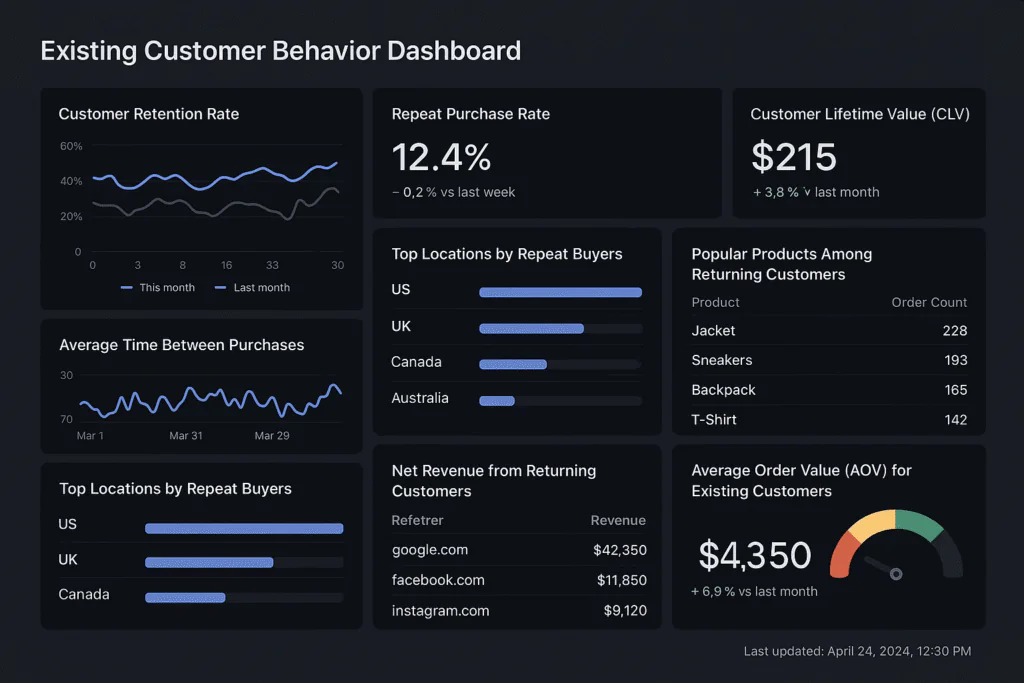
Your existing customers are your best teachers. They’ve already proven they’re willing to pay for what you offer, which means they represent your brand’s target audience in action.
Look beyond basic demographics to understand deeper patterns. While age and location matter, purchasing behavior, motivations, and decision-making processes reveal more valuable insights.
Start by gathering this information from your current customer base:
- Purchase intention and patterns:
When do customers buy? How often? What triggers purchase decisions? A software company might discover that customers typically purchase after using the free version for exactly 14 days, indicating the optimal outreach timing.
- Problem-solving behavior:
Identify problems customers sought to solve when discovering your brand and how they managed before. Did they use competitors’ products, DIY methods, or nothing? These insights reveal what you’re replacing, clarify your value proposition, and highlight specific pain points your solution addresses.
- Discovery paths:
Learning how customers discovered you, through social media, search, referrals, or industry events, reveals where your ideal target audience spends time and which channels they trust. This knowledge focuses your marketing efforts on platforms attracting high-quality leads.
Gather data using existing analytics tools. Google Analytics displays website behavior patterns. Your CRM shows purchase histories and customer interactions. Customer service logs reveal common questions and concerns.
Focus on patterns beyond data collection. Analyzing 50-100 customers reveals repeatedly appearing characteristics. These patterns form the foundation for identifying additional individuals with similar traits and behaviors.
Build Detailed Customer Profiles
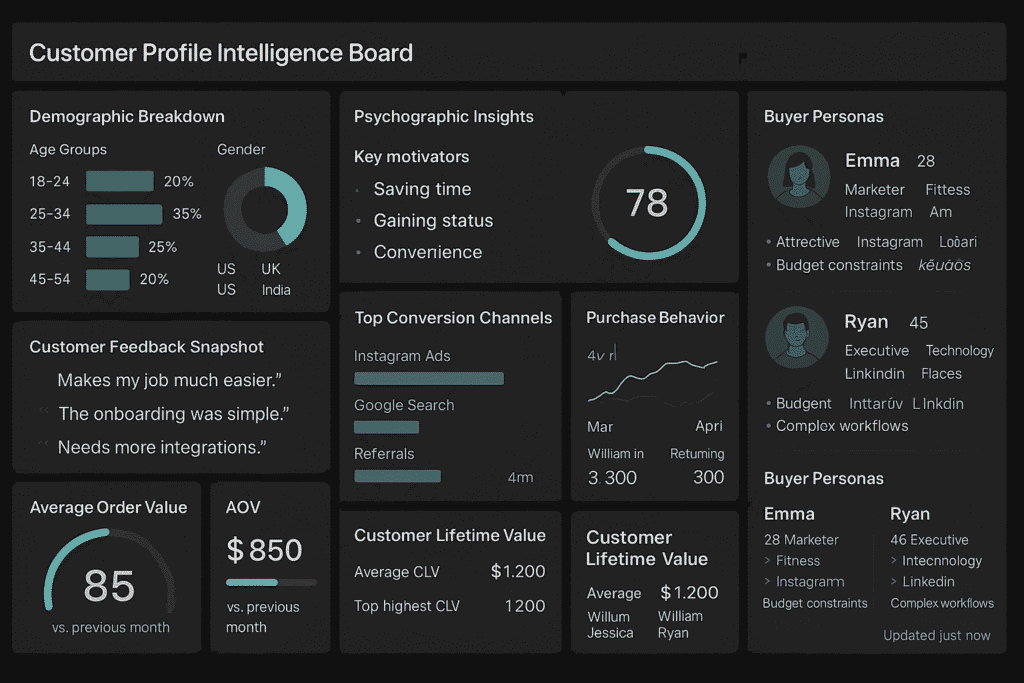
After understanding existing customers, create detailed profiles of ideal prospects. Develop character profiles representing thousands of real people.
Businesses often create overly general customer profiles. Describing your target audience as “small business owners aged 25–45” lacks usefulness. Strong profiles combine demographics with psychographics to reveal who customers are and why they buy. Well-defined target audience examples demonstrate what useful profiles contain.
A complete customer profile includes:
- Basic demographics information:
Demographics include age, location, income, and job title. Gather details relevant to your business. B2B software companies need job titles and company sizes to target their audiences. Local restaurants require neighborhood information and dining preferences.
- Deeper motivations behind the purchasing decision:
Determine what drives customer decisions. Do they seek to save time, improve image, increase security, or gain status? A productivity app attracts busy executives wanting efficiency and overwhelmed parents needing organization, the same product, different motivations.
- Information consumption habits:
Understanding their consumption habits helps you reach them more effectively. If you understand where they go for news, advice, or recommendations, like blogs, podcasts, or social media, you can show up in those spaces with the right message, in the right format, at the right time.
- Buying behavior:
Consumer behavior insights help tailor your sales strategy more effectively. Do they spend weeks researching and reading reviews, or do they buy on impulse? Do they need approval from others, like a boss or partner, or do they decide on their own? Understanding this enables you to align your offer with the buyer’s decision-making style, increasing the likelihood of closing the sale.
Complete customer profiles uncover what truly drives your target audience, their motivations, habits, and buying behaviors. The right target audience for your product emerges when these profiles reveal customers whose specific needs, pain points, and purchasing behaviors align perfectly with what your product or service solves, enabling you to match your offering with the people most likely to buy.
Study Your Competitors’ Audiences
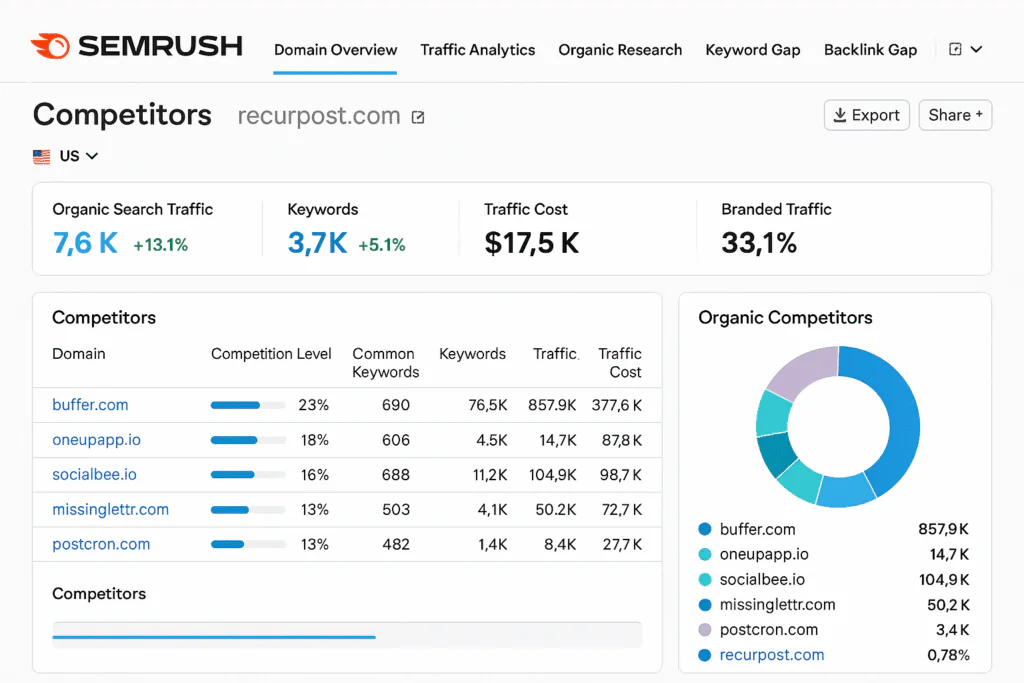
Your competitors have already invested significant time and money into identifying who buys products like yours. Competitors’ target audiences become discoverable through social media analysis, website traffic tools like SimilarWeb and SEMrush, and content engagement patterns that reveal which customer segments respond to similar products or services, allowing you to shortcut months of audience research and uncover overlooked opportunities.
This isn’t copying them, but mapping the broader landscape of people interested in your category. This target market intelligence reveals opportunities.
Start with social media analysis. Look at who follows your competitors, who engages with their content, and what types of posts get the most response. Pay attention to the comments; they often reveal the target audience’s pain points, questions, and language that your shared target audience uses.
Next, analyze their website traffic and content strategy. Tools like SimilarWeb and SEMrush reveal your competitors’ audience demographics, interests, and behavior trends. This reveals not just who their customers are, but how they think and what they care about.
Here’s what to look for specifically:
- Engagement patterns:
Identify which competitor posts get the most likes, shares, and comments on social media platforms. This reveals what content truly connects with your shared audience. For example, a fitness equipment brand might find that workout tips perform better than product promotions, indicating their target audience prefers helpful, educational content over direct sales messages.
- Community discussions:
Pay attention to the questions and complaints people leave in competitors’ social media comments. These reveal unmet needs, frustrations, or service gaps, valuable insights your business can use to offer better solutions and stand out.
- Content themes:
Look at the topics your successful competitors focus on most. This highlights what your target audience refers to and is interested in, helping you create content that aligns with their needs and keeps them engaged.
- Language and tone:
Observe how your competitors communicate, do they use a formal or casual tone, technical terms, or simple language? Their tone reveals how your shared audience prefers to be spoken to, helping you match your messaging style accordingly.
Competitor analysis reveals target audience segments you might not have considered. Maybe you thought you were targeting small business owners, but you discovered a significant segment of corporate managers who buy similar products for different reasons. That’s a new opportunity worth exploring.
Listen to Online Conversations
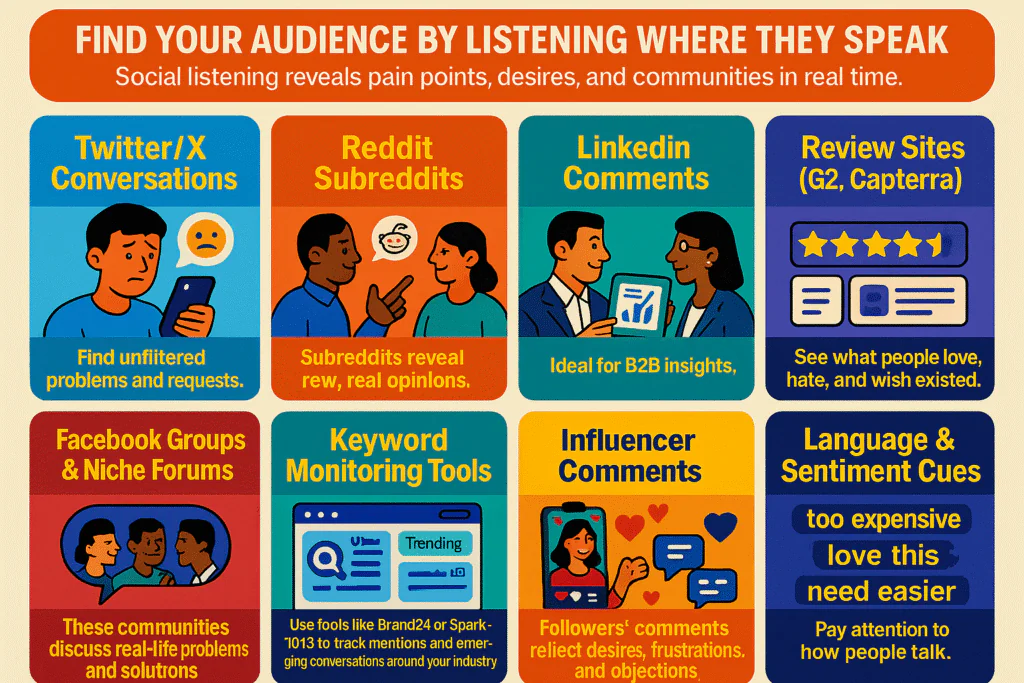
Social listening shows you what potential customers think and feel.
This gives you access to thousands of private conversations about your industry.
Social listening encompasses monitoring mentions of your brand, competitors, and industry keywords across social media, forums, and review sites. Its value comes from uncovering broader conversations about the problems your product solves.
For example, if you sell project management software, don’t just monitor mentions of your brand or competitors. Monitor conversations about “team communication problems”, “missed deadlines”, “project chaos”, and “remote work challenges”. These conversations reveal people actively experiencing the problems you solve.
Here’s where to listen and what to look for:
- Twitter/X conversations:
Search for keywords related to your industry’s problems. Social media platforms like Twitter/X reveal target audiences through conversations where people share frustrations, ask for recommendations, or discuss challenges, allowing businesses to identify potential customers by monitoring hashtags, mentions, and industry-specific discussions.
- Reddit discussions:
Subreddits are rich sources of genuine, unfiltered conversations. Explore those related to your industry, your customers’ roles, or the problems you solve. Highly upvoted posts and comments highlight common pain points, interests, and opinions, giving you valuable insights into what truly matters to your target audience.
- LinkedIn posts and comments:
This is especially valuable for B2B businesses. Look for posts discussing industry challenges, and dive into the comments to uncover diverse perspectives, real-world experiences, and recurring pain points your solution can address.
- Review sites and forums:
Platforms like G2, Capterra, and industry-specific forums are goldmines for insight. Focus on competitor reviews to understand what customers love, what frustrates them, and what features or support they feel are missing, revealing opportunities for your business to stand out.
Discover not just what people need, but how they think about those needs. Do they call it “team collaboration” or “getting everyone on the same page”? Do they focus on efficiency or reducing stress? This language becomes the foundation of messages that truly resonate.
Track Industry Trends and Shifts
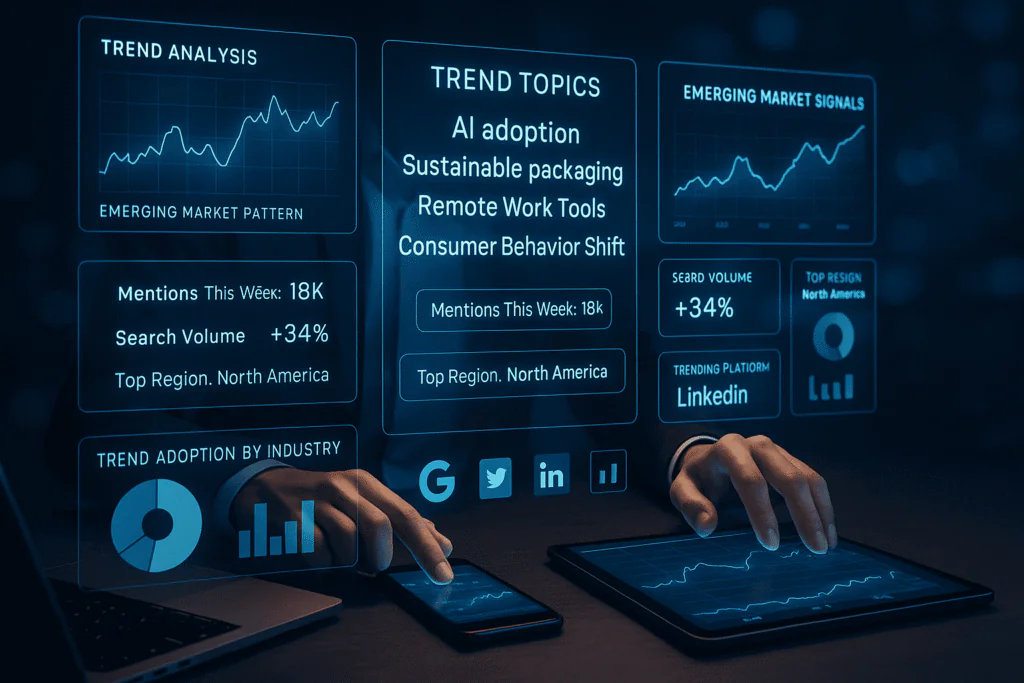
Target audiences change with evolving industries, new technologies, and cultural shifts. Identifying trends early helps you discover new audience segments before competitors.
The pandemic created entirely new target audience segments overnight. Suddenly, restaurant owners needed delivery platforms, teachers needed video conferencing tools, and fitness instructors needed online class solutions. Companies that spotted these emerging needs early captured significant target market share.
Here’s how to identify and capitalize on audience shifts:
- Monitor search trends:
Google Trends shows you what people are searching for over time. Look for rising interest in topics related to your industry. A gradual increase in searches for “sustainable packaging” might indicate a growing segment of environmentally conscious consumers.
- Follow industry publications:
Trade magazines, industry blogs, and research reports often highlight emerging trends, challenges, and opportunities. These insights can help you identify new audience segments and adapt your strategy to meet their evolving needs.
- Attend virtual conferences and webinars:
Spokespersons often share insights on emerging trends and challenges, while target audience questions during Q&A sessions reveal real-time pain points, concerns, and interests, offering a direct window into what your target audience cares about most.
- Track regulatory and technological changes:
New laws, technologies, or industry standards often create fresh needs and opportunities. For example, GDPR sparked demand for privacy compliance tools, while advances in remote work technology boosted the need for collaboration software. Staying alert to these shifts helps you spot and serve emerging market demands.
Connect these broader trends to specific people with specific needs. A trend toward “sustainable business practices” becomes actionable when you identify that marketing managers at mid-size companies are now required to report on sustainability initiatives and need tools to track their progress.
This approach helps you spot opportunities early. By the time everyone is talking about a trend, the market is often saturated. But when you identify emerging needs as they develop, you can position yourself as the obvious solution.
Ask Your Audience Directly
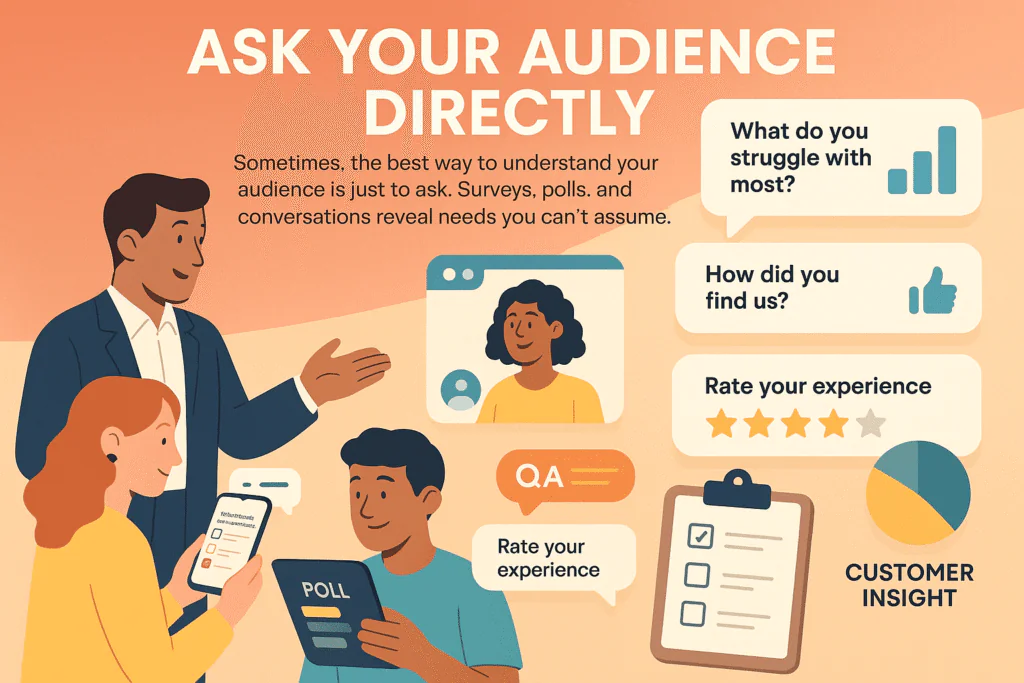
Directly asking people about their thoughts, feelings, and needs is a powerful research method. Surveys and interviews reveal insights that data analysis alone cannot capture.
How you ask determines what you learn. Generic surveys produce generic insights. Specific, thoughtful questions reveal the deep motivations and decision-making processes that transform your marketing.
The most valuable questions aren’t about the target audience’s preferences. They’re about problems, emotions, and decision-making processes:
- Problem-focused questions:
“What’s the most frustrating part of [relevant process]?” “What keeps you up at night about [industry challenge]?” “If you could wave a magic wand and fix one thing about [relevant area], what would it be?”
- Process questions:
“Walk me through the last time you [solved this problem/made this type of purchase/faced this challenge].” “What almost stopped you from [buying/trying/continuing]?” “Who else needs to approve decisions like this?”
- Language questions:
How would you describe this problem to a colleague? What would you Google if you were looking for a solution?, This reveals the exact words your target audience uses, which become your marketing copy.
- Alternative solutions:
How do you currently handle this? What other options did you consider? This shows you what you’re competing against, and it’s often not other products in your category.
For customer interviews, aim to conduct 15–20 conversations with a mix of current customers, potential buyers, and those who chose not to purchase. The goal isn’t statistical significance; it’s understanding the stories behind the data.
Surveys work well for broader validation. Once interviews reveal patterns, surveys can show you how widespread those patterns are across your entire audience.
Explore Online Communities and Forums For Deeper Understanding
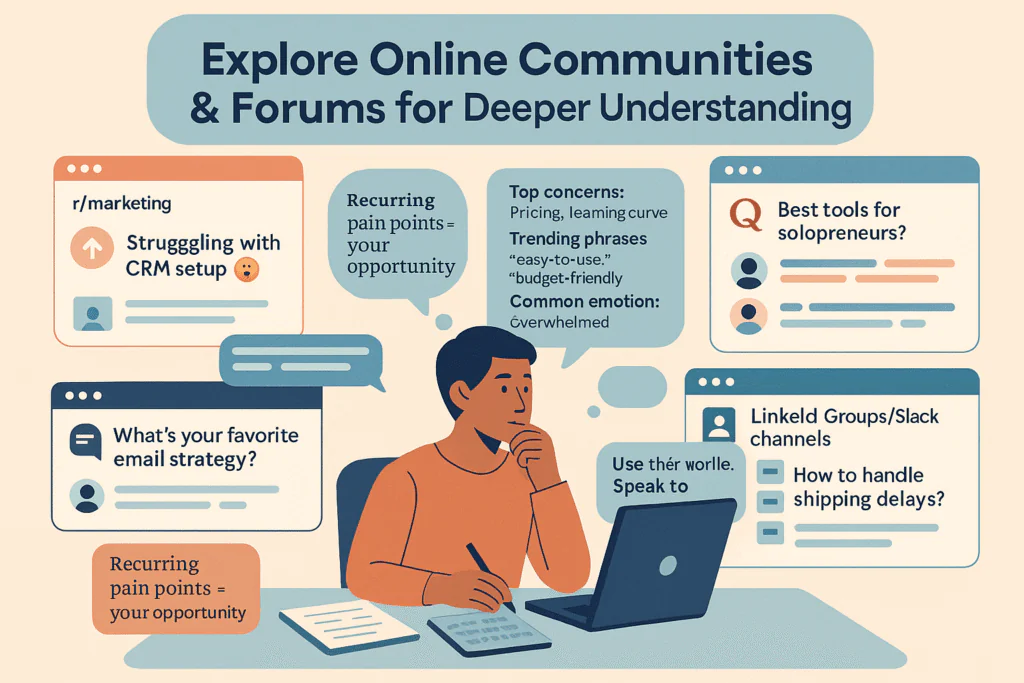
In online communities, potential customers openly share experiences, ask questions, and seek advice. These function as authentic, always-on focus groups where people speak freely without knowing they’re being observed.
The key is identifying the right communities. Your ideal customers aren’t just in industry-specific groups; they’re also active in spaces tied to their roles, challenges, and interests. For instance, if you sell email marketing software, you’ll likely find them in:
- Marketing forums (skill-based)
- Small business owner groups (role-based)
- E-commerce communities (industry-specific)
- Entrepreneur networks (identity-driven)
When exploring these communities, pay close attention to:
- Common Questions and Challenges
Pay attention to what people ask repeatedly. These common questions often reveal major pain points or unmet needs your product or service could address. If you see the same frustrations come up often, you’ve likely uncovered a genuine target market opportunity.
- Language and Terminology
Note how people describe their problems, goals, and frustrations. The words and phrases they use naturally should influence your messaging. Speaking in their language builds connection and makes your marketing feel relatable and relevant.
- Recommended Tools and Services
Watch for tools, services, or platforms that community members frequently recommend. These mentions can point to your direct competitors, but also to alternative or complementary solutions your target audience already trusts. This insight helps you better position your offering.
- Successes and Failures
When users share what worked or didn’t work for them, they’re giving you a window into their decision-making process. You’ll learn what they value most, what they avoid, and where other solutions fall short, so you can fill those gaps.
- Community Culture and Values
Each community has its style, tone, and values. Some may prefer data-backed advice, others respond better to storytelling or casual conversation. Understanding these norms helps you engage meaningfully without seeming out of place or overly promotional.
Read between the lines for the most valuable insights. When someone asks, “What’s the best project management tool?” they might be saying, “I’m drowning in disorganized work and my team is frustrated with me.” That emotional context is what transforms features into key benefits.
Analyze Your Email Subscriber Behavior For Strategic Targeting
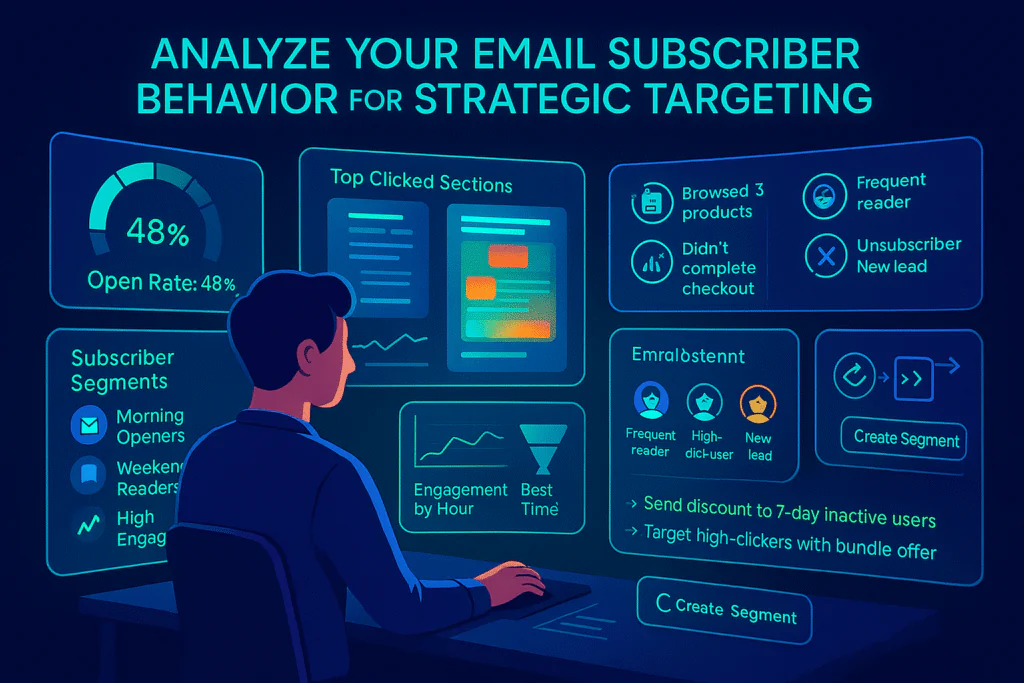
Your email list contains individuals already interested in your brand, forming a highly targeted audience segment. Analyzing subscriber behavior helps identify distinct segments with different needs and preferences, enhancing customer relationships.
Email behavior reveals preferences that other data sources miss. Two people might have similar demographics but completely different engagement patterns; one reads every email immediately, while the other only opens emails about specific topics. These differences indicate different motivations and needs.
Start by segmenting your list based on behavior:
- Engagement levels:
Subscribers who frequently open, click, and respond to your emails are often a strong reflection of your ideal customer. But don’t stop at email metrics, dig deeper. Examine what else these engaged individuals do: Do they attend your webinars, comment on your social posts, or make repeat purchases?
Analyzing these patterns reveals shared traits, interests, and behaviors that can help you build more accurate customer profiles
- Content preferences:
Which email topics get the highest open and click rates from different subscriber segments? This reveals what different groups care about most.
- Timing patterns:
When different segments open and engage with your emails reveals their roles, daily routines, and geographic locations. For example, early morning opens might suggest busy professionals checking emails before work, while evening engagement could indicate freelancers or global audiences in different time zones.
These patterns help optimize send times while revealing the daily habits and preferences of your target segments.
- Action patterns:
Do some subscribers consistently click on educational content while others only respond to promotional offers? This indicates different stages in the buyer’s journey or different motivations.
For deeper insights, survey your most engaged email subscribers. They’ve already demonstrated interest in your brand, so they’re often willing to share detailed customer feedback about their needs, challenges, and decision-making processes.
You can also test different messaging approaches with different segments. Send the same offer with different positioning, one emphasizing time savings, another emphasizing cost savings, and see which resonates with which groups.
Additional Way to Find Target Audience | Leverage AI
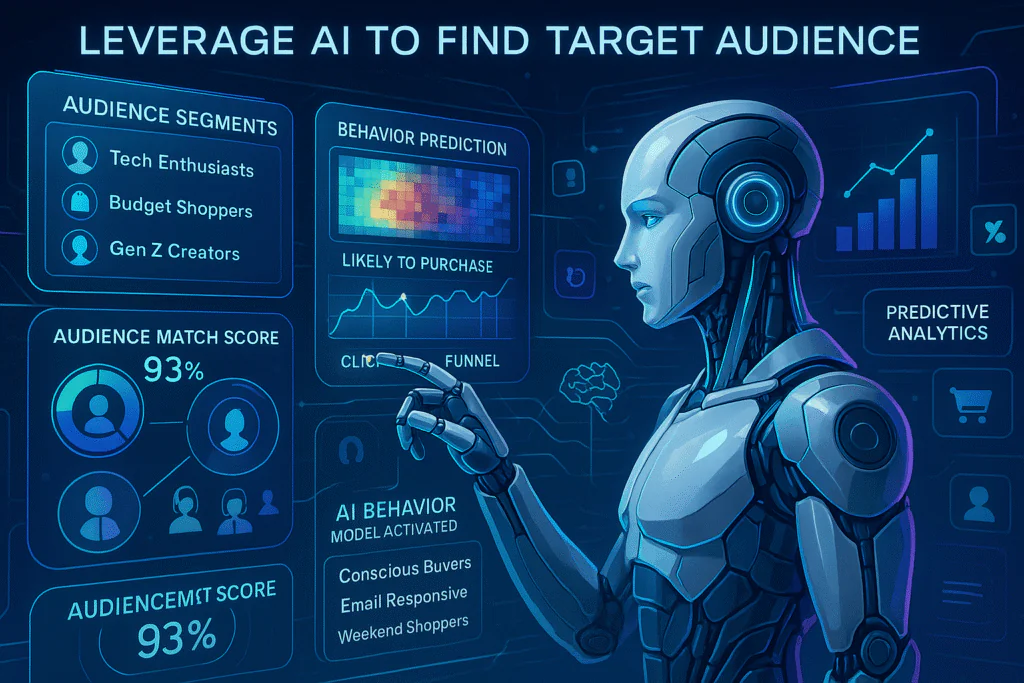
AI and advanced analytics process vast data sets to reveal audience patterns impossible to spot manually. These tools identify unexpected connections and emerging trends.
Modern AI tools analyze customer data, industry trends, social media activity, website behavior, and market insights to uncover overlooked target audience segments and characteristics.
Here’s how to use AI effectively for target customer research:
- Customer data analysis:
AI can analyze your customer database to identify hidden segments based on purchase patterns, behavior, and characteristics that aren’t obvious to human analysis.
- Social media platform insights:
Tools like SparkToro use AI to analyze what your target audience pays attention to online, what they follow, share, and engage with across platforms.
- Content analysis:
AI can analyze customer reviews, support tickets, and social media mentions to identify common themes, sentiment patterns, and language preferences.
- Predictive modeling:
Advanced platforms can predict which prospects are most likely to become customers based on behavior patterns and characteristics.
- Competitive intelligence:
AI tools can analyze competitor audiences at scale, revealing target market opportunities and uncovering gaps you can capitalize on.
With AI tools, ask the right questions and interpret results in context. AI excels at finding patterns, but you need human judgment to understand what those patterns mean for your business strategy.
For example, an AI analysis might reveal that your customers are 40% more likely to engage with content on Tuesday afternoons. That’s interesting data, but the strategic insight is that your audience might be knowledge workers who catch up on industry content mid-week when their schedules are less hectic.
Putting It All Together for Effective Audience Targeting
Combine these 9 methods strategically rather than trying to do everything at once. The audience identification process works like building a puzzle, where each method provides different pieces that businesses implement sequentially to create a complete picture of their target market.
Here’s how to prioritize your research efforts:
- Start with what you have:
Begin with Method 1 (analyzing existing customers) because it’s free and provides immediate insights. This becomes your foundation for everything else.
- Add external perspectives:
Leverage Methods 3 and 4, competitor analysis and social listening, to gain a broader market perspective and uncover gaps or growth opportunities.
- Validate with direct research:
Use Methods 6 and 7 (surveys/interviews and community research) to confirm your hypotheses and understand the “why” behind the patterns you’ve observed.
- Test and refine:
Use Methods 8 and 9 (email analysis and advertising tests) to validate your understanding with real behavior and optimize your messaging.
- Scale with technology:
Use Method 9(AI and analytics) to process larger datasets and identify patterns across all your research.
Aim for actionable insights that improve your marketing effectiveness, not perfect information. You’re looking for patterns strong enough to base decisions on, not academic-level certainty.
Treat audience research as an ongoing process, not a one-time project. Your audience evolves, new segments emerge, and market conditions change. Revisit how you conduct market research quarterly, and be prepared to refine your insights as new information emerges.
Common Mistakes That Waste Time and Money
Even with the right methods, mistakes can lead to misleading results or wasted resources. Here are the most common pitfalls and how to avoid them:
- Mistake 1: Confusing correlation with causation.
Just because two characteristics appear together doesn’t mean one causes the other. Your customers might all live in urban areas and have college degrees, but that doesn’t mean urban living or education drives their purchase decisions.
- Mistake 2: Over-relying on demographics.
Age, gender, and location are easy to measure but often less important than motivations, challenges, and decision-making processes. Two 35-year-old managers might have completely different needs based on their company size, industry, and role responsibilities.
- Mistake 3: Assuming your loudest customers represent everyone.
The people who leave reviews, send emails, and engage on social media aren’t necessarily representative of your entire customer base. Make sure your research includes input from quieter customers, too.
- Mistake 4: Ignoring people who didn’t buy.
Learning why prospects decided against your product is often more valuable than understanding why customers purchased it.. Those “no” reasons reveal barriers you need to address.
- Mistake 5: Stopping research after launch.
Your initial understanding is just a starting point. Continuous research reveals how your audience evolves and contributes to you spot new opportunities before competitors do.
Your Next Steps: From Research to Results
Target audience insights only create value when you act on them. Here’s how to transform your research insights into practical improvements:
- Refine your messaging: Use the language your audience uses. Replace industry jargon with terms your customers recognize. Focus on the problems they want to solve, not just the features you offer.
- Adjust your marketing channels: If your research reveals that your audience prefers LinkedIn over Facebook, or podcasts over blogs, shift your resources accordingly. Meet your audience where they already spend time.
- Improve your product or service: Audience research often reveals unmet needs or frustrations with current solutions. These insights can guide product development and service improvements.
- Personalize your approach: Different audience segments need different approaches. Create tailored content, offers, and communication strategies for each major segment you’ve identified.
- Optimize your sales process: Understanding how your audience makes decisions helps you structure your sales process to align with their natural buying journey.
Businesses that invest in understanding their customers achieve long-term success. These businesses understand not just what customers buy, but why they buy, how they think, and what matters most to them.
Getting Started: Your Target Audience Research Action Plan
Find your ideal customers by starting with one method most relevant to your situation. Begin with the method most relevant to your current situation. Gather insights, test them in your marketing, and measure the results. Then, gradually add other audience research methods to deepen and expand your understanding.
While no perfectly defined target audience exists, a better understanding leads to improved business performance. Every insight you gain makes your marketing more effective, your products more valuable, and your customers more satisfied.
Your ideal customers are actively searching for what you offer, and these proven methods will help you find them.
Frequently Asked Questions About Finding Your Target Audience
1. How do I find my target audience for free?
Start by analyzing your existing customers using free tools like Google Analytics, social media insights, and customer surveys. Monitor online communities where your potential customers gather, such as Reddit forums, Facebook groups, and industry-specific communities. Use Google Trends to understand search behavior and social listening through free tools like Google Alerts to track conversations about your industry.
2. What is the difference between the target audience and the target market?
Your target market refers to the larger group of individuals who may have an interest in purchasing your product or service. Your target audience is a specific segment within that market that you’re actively trying to reach with your marketing campaigns. For example, your target market might be “small business owners,” while your target audience could be “marketing managers at tech startups with 10-50 employees.”
3. How do I know if I’ve identified the right target audience?
You’ll know you’ve found the right target audience when you see higher engagement rates, better conversion rates, and more qualified leads. Your marketing messages will resonate more strongly, customers will refer others more frequently, and you’ll spend less money acquiring each new customer. Track key metrics like click-through rates, conversion rates, and customer lifetime value to measure success.
4. How often should I research my target audience?
Audience research should be an ongoing process, not a one-time activity. Review your audience data quarterly and conduct comprehensive research annually. Markets evolve, new competitors emerge, and customer preferences change. Set up continuous monitoring through social listening tools and regularly survey your customers to stay current with their needs.
5. Can a business have multiple target audiences?
Yes, most successful businesses serve multiple target audiences or customer segments. However, each audience should have distinct characteristics and receive tailored messaging. For example, a project management software company might target both small business owners and enterprise team managers, but with different marketing approaches for each group.
6. What tools are essential for target audience research?
Essential audience research tools include Google Analytics for website behavior, social media analytics for engagement insights, survey platforms such as Typeform or Google Forms, social listening tools like Hootsuite or Mention, and competitive analysis tools like SEMrush or SimilarWeb. These target audience tools automate data collection and analysis processes that would otherwise require manual research, allowing businesses to gather demographic information, behavioral patterns, and engagement metrics efficiently.

Fenil Patel is a content writer specializing in social media marketing. He creates engaging, results-driven content that helps brands grow online, connect with audiences, and boost digital visibility. With a sharp eye for trends and strategy, he turns ideas into content that performs. Fenil is passionate about helping businesses stand out in the fast-paced world of digital marketing.
